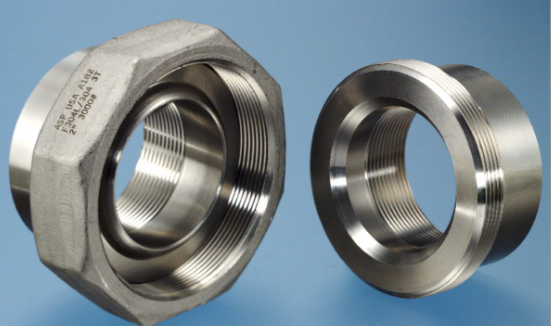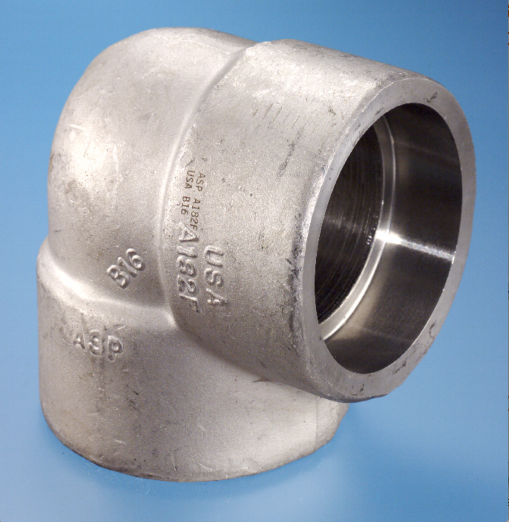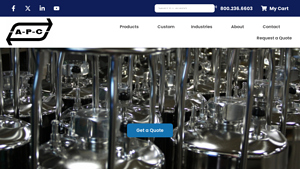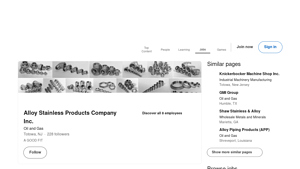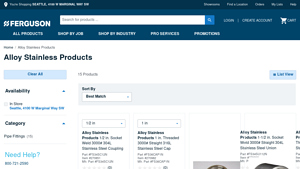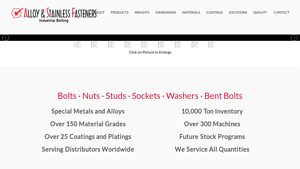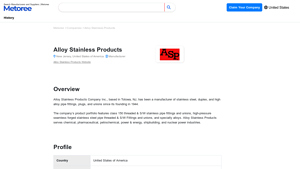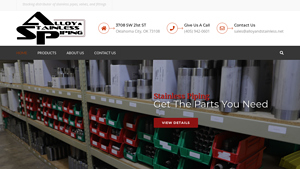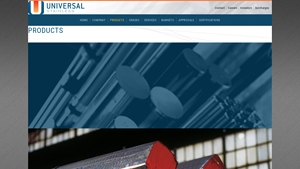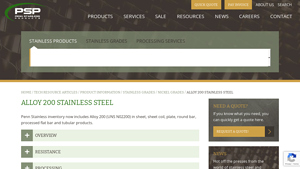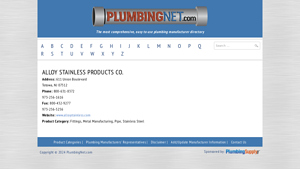Alloy Stainless Products Guide: Type, Cost, Top List…
Introduction: Navigating the Global Market for alloy stainless products
In today’s global economy, sourcing high-quality alloy stainless products poses a significant challenge for international B2B buyers. As industries across Africa, South America, the Middle East, and Europe continue to evolve, the demand for durable and versatile materials has surged. This guide aims to demystify the complexities of the alloy stainless market, providing a comprehensive overview of various product types, their applications, and key factors to consider when selecting suppliers.
From stainless steel fittings and pressure vessels to custom fabrication services, understanding the specifications and standards associated with these products is crucial for making informed purchasing decisions. Moreover, we will delve into supplier vetting processes, cost considerations, and the importance of compliance with international standards. By addressing these pivotal areas, this guide equips B2B buyers with the insights necessary to navigate the global marketplace effectively.
Whether you are a purchasing manager in Brazil looking for reliable suppliers or a project engineer in Vietnam seeking specialized components, this resource empowers you with actionable strategies to enhance your procurement processes. With our authoritative insights and practical advice, you can confidently source alloy stainless products that meet your operational needs while ensuring quality and compliance across borders.
Understanding alloy stainless products Types and Variations
| Type Name | Key Distinguishing Features | Primary B2B Applications | Brief Pros & Cons for Buyers |
|---|---|---|---|
| Stainless Steel (304) | Excellent corrosion resistance, good formability | Food processing, chemical handling | Pros: Cost-effective, versatile; Cons: Limited high-temperature resistance. |
| Stainless Steel (316) | Enhanced corrosion resistance, particularly against chlorides | Marine applications, pharmaceuticals | Pros: Superior durability; Cons: Higher cost compared to 304. |
| Duplex Stainless Steel | Balanced microstructure of austenite and ferrite | Oil & gas, petrochemical sectors | Pros: High strength, good corrosion resistance; Cons: More difficult to weld. |
| Nickel Alloys | Excellent heat and corrosion resistance at high temperatures | Aerospace, chemical processing | Pros: Exceptional performance in extreme conditions; Cons: Higher material costs. |
| Specialty Alloy Products | Customizable to specific requirements and specifications | Aerospace, automotive, and industrial | Pros: Tailored solutions for unique needs; Cons: Longer lead times for production. |
What Are the Characteristics and Applications of Stainless Steel 304?
Stainless Steel 304 is one of the most commonly used grades, known for its excellent corrosion resistance and good formability. This alloy is suitable for a wide range of applications, particularly in food processing and chemical handling, where hygiene and durability are critical. When considering a purchase, buyers should evaluate the environmental conditions the material will face, as 304 may not perform well in high-temperature settings. Its cost-effectiveness makes it a popular choice among manufacturers, but its limitations in specific applications should be understood.
How Does Stainless Steel 316 Differ from 304?
Stainless Steel 316 offers enhanced corrosion resistance, particularly against chlorides, making it ideal for marine applications and pharmaceutical industries. This grade is often preferred over 304 in environments that are prone to saltwater exposure or where stringent sanitary conditions are necessary. Buyers should consider the higher initial cost of 316 compared to 304; however, the long-term durability and reduced maintenance costs can justify the investment. Understanding the specific application requirements will help in making an informed purchasing decision.
What Are the Benefits of Duplex Stainless Steel?
Duplex Stainless Steel features a balanced microstructure of austenite and ferrite, providing high strength and excellent resistance to corrosion. This makes it particularly suitable for demanding applications in the oil and gas and petrochemical sectors, where both strength and resistance to pitting and stress corrosion cracking are essential. While its benefits are significant, buyers must be aware that duplex stainless steel can be more challenging to weld and may require specialized techniques. Evaluating the manufacturing capabilities and expertise of suppliers is crucial when sourcing this material.
Why Choose Nickel Alloys for High-Temperature Applications?
Nickel Alloys are specifically designed to withstand extreme temperatures and corrosive environments, making them ideal for aerospace and chemical processing applications. Their superior performance under high-stress conditions often justifies the higher material costs associated with these alloys. B2B buyers should assess the specific operational temperatures and chemical exposures their applications will encounter to ensure they select the right alloy. The investment in nickel alloys can lead to significant long-term savings due to their durability and reliability.
What Are Specialty Alloy Products and Their Advantages?
Specialty Alloy Products are tailored to meet unique specifications and requirements for various industries, including aerospace, automotive, and industrial applications. These products can be customized in terms of composition, dimensions, and performance characteristics, allowing for optimal fit and function in specific applications. While the ability to customize offers significant advantages, buyers should consider the potential for longer lead times in production and delivery. Engaging with suppliers early in the design process can help mitigate delays and ensure that the final product meets all necessary standards and specifications.
Key Industrial Applications of alloy stainless products
| Industry/Sector | Specific Application of alloy stainless products | Value/Benefit for the Business | Key Sourcing Considerations for this Application |
|---|---|---|---|
| Pharmaceutical | ASME Stainless Steel Pressure Vessels | Ensures compliance with safety and quality standards | Need for certifications (ASME, FDA) and customization options |
| Chemical Processing | Custom Alloy Piping Systems | Enhances safety and efficiency in hazardous environments | Resistance to corrosion and high-pressure requirements |
| Oil & Gas | Duplex Stainless Steel Components | Provides durability and cost-effectiveness in harsh conditions | Availability of materials suitable for offshore applications |
| Food & Beverage | Sanitary Stainless Steel Fittings and Tanks | Maintains hygiene and product integrity | Compliance with food safety regulations and certifications |
| Aerospace | Lightweight Alloy Components | Reduces weight and improves fuel efficiency | Precision engineering and adherence to strict aerospace standards |
What Are the Key Applications of Alloy Stainless Products in the Pharmaceutical Sector?
In the pharmaceutical industry, ASME stainless steel pressure vessels are essential for the safe storage and processing of chemicals. These vessels must meet stringent regulations, including ASME and FDA standards, ensuring that they can withstand high pressures and temperatures without compromising safety. For international buyers, sourcing these products requires an understanding of local regulatory requirements and the supplier’s ability to provide custom solutions tailored to specific processes.
How Are Alloy Stainless Products Used in Chemical Processing?
Custom alloy piping systems are vital in chemical processing, where they facilitate the safe transport of corrosive substances. Alloy stainless products are engineered to resist corrosion and withstand extreme pressures, significantly enhancing operational efficiency and safety. B2B buyers must consider the specific material grades required for their applications, as well as the supplier’s capability to deliver products that meet rigorous industry standards.
What Role Do Alloy Stainless Products Play in the Oil & Gas Industry?
In the oil and gas sector, duplex stainless steel components are commonly used due to their exceptional strength and corrosion resistance. These materials are particularly beneficial in offshore applications where environmental conditions are harsh. Buyers in this industry should prioritize sourcing from suppliers that can provide high-quality materials that meet the demanding specifications of offshore environments, including resistance to pitting and stress corrosion cracking.
How Are Alloy Stainless Products Beneficial for the Food & Beverage Industry?
The food and beverage industry relies heavily on sanitary stainless steel fittings and tanks to ensure product safety and hygiene. Alloy stainless products help maintain the integrity of consumables by preventing contamination during processing and storage. Buyers must ensure that suppliers comply with food safety regulations and can provide certifications to guarantee the quality and safety of their products.
Why Are Alloy Stainless Products Important in Aerospace Applications?
Lightweight alloy components are critical in the aerospace industry, where reducing weight can lead to improved fuel efficiency and performance. Alloy stainless products used in aircraft must meet stringent aerospace standards for strength and durability. International buyers should seek suppliers with expertise in aerospace applications and the ability to provide precision-engineered components that adhere to strict regulatory requirements.
3 Common User Pain Points for ‘alloy stainless products’ & Their Solutions
Scenario 1: Sourcing High-Quality Alloy Stainless Products for Specialized Applications
The Problem: B2B buyers often struggle to find high-quality alloy stainless products that meet specific industry standards and performance criteria. For instance, a pharmaceutical company may require stainless steel vessels that adhere to ASME standards while also being resistant to corrosion and easy to clean. This challenge is compounded by the fact that suppliers may not provide clear certifications or documentation, leading to uncertainty about the product’s reliability and compliance with regulatory requirements.
The Solution: To overcome this sourcing challenge, buyers should prioritize suppliers who can provide detailed product specifications and certifications. When researching potential vendors, look for those with a proven track record in your industry, such as those specializing in pharmaceutical or chemical applications. Request samples and third-party certifications that validate the quality and compliance of the products, ensuring they meet necessary standards. Engaging in a dialogue with suppliers about your specific needs can also lead to tailored solutions, such as customized alloy compositions or finishes that improve performance in your application. Additionally, using a centralized procurement platform can streamline sourcing, making it easier to compare suppliers and their offerings based on quality metrics.
Scenario 2: Managing Supply Chain Disruptions in Alloy Stainless Product Procurement
The Problem: Supply chain disruptions, whether due to geopolitical factors, natural disasters, or logistical challenges, can severely impact the availability of alloy stainless products. Buyers may find themselves facing delays in project timelines or increased costs due to unexpected shortages. This is particularly problematic for industries such as oil and gas or construction, where timely access to materials is crucial for maintaining operations and meeting contractual obligations.
The Solution: To mitigate the impact of supply chain disruptions, B2B buyers should adopt a proactive supply chain management strategy. This involves establishing relationships with multiple suppliers across different geographic regions to reduce dependency on any single source. Implementing a just-in-time inventory system can also help maintain adequate stock levels without overcommitting resources. Additionally, consider investing in inventory management software that provides real-time data on stock levels and supplier performance. This technology allows for better forecasting and planning, enabling buyers to anticipate potential shortages and adjust orders accordingly. Engaging in regular communication with suppliers about their capacity and potential risks can also provide critical insights that help in planning for contingencies.
Scenario 3: Ensuring Proper Installation and Maintenance of Alloy Stainless Products
The Problem: Even the highest-quality alloy stainless products can underperform if they are not installed or maintained correctly. Buyers may face issues such as leaks, corrosion, or structural failures due to improper installation techniques or lack of maintenance. This can lead to costly repairs, downtime, and even safety hazards, particularly in industries like food processing or pharmaceuticals where hygiene and safety are paramount.
The Solution: To ensure the longevity and performance of alloy stainless products, buyers should invest in comprehensive training for their installation and maintenance teams. This includes understanding the specific requirements for handling and installing various alloys, as well as regular maintenance protocols. Collaborate with suppliers to access training resources, such as installation manuals, online training modules, and on-site workshops. Additionally, implementing a maintenance schedule that includes regular inspections and cleaning can prevent issues before they escalate. Utilizing third-party service providers who specialize in alloy stainless products can also be beneficial for complex installations or maintenance tasks, ensuring that best practices are followed. By prioritizing proper installation and maintenance, companies can significantly reduce the risk of operational disruptions and extend the lifespan of their alloy stainless products.
Strategic Material Selection Guide for alloy stainless products
What Are the Key Properties of Common Materials Used in Alloy Stainless Products?
When selecting materials for alloy stainless products, understanding the properties and suitability of various alloys is crucial. Here, we analyze four common materials: 304 Stainless Steel, 316 Stainless Steel, Duplex Stainless Steel, and Nickel Alloys.
304 Stainless Steel: The Versatile Workhorse
304 stainless steel is one of the most widely used alloys in various industries due to its excellent corrosion resistance and good mechanical properties. It can withstand temperatures up to 870°C (1600°F) in intermittent service and 925°C (1700°F) in continuous service.
Pros: It is relatively low-cost, easy to fabricate, and offers good durability, making it suitable for a wide range of applications, including food processing, chemical storage, and architectural components.
Cons: However, it has limited resistance to saltwater and acidic environments, which may lead to pitting and crevice corrosion.
Impact on Application: 304 stainless steel is ideal for applications involving non-corrosive media but may not be suitable for marine or highly acidic environments.
Considerations for International Buyers: Compliance with ASTM standards is essential, as many regions require adherence to specific regulations for food and chemical applications.
316 Stainless Steel: Enhanced Corrosion Resistance
316 stainless steel is often chosen for its superior corrosion resistance, particularly in chloride environments. It can handle temperatures up to 870°C (1600°F) and is often used in marine applications and chemical processing.
Pros: Its molybdenum content significantly enhances its resistance to pitting and crevice corrosion, making it suitable for harsher environments.
Cons: The increased alloying elements make it more expensive than 304 stainless steel, which could impact budget considerations for large-scale projects.
Impact on Application: 316 stainless steel is particularly effective for applications involving saltwater or acidic chemicals, ensuring longevity and reliability.
Considerations for International Buyers: Buyers should ensure compliance with international standards like ASTM and DIN, particularly in industries such as pharmaceuticals and food processing.
Duplex Stainless Steel: Strength and Corrosion Resistance
Duplex stainless steel combines the properties of both austenitic and ferritic stainless steels, offering high strength and excellent corrosion resistance. It can withstand temperatures up to 300°C (572°F) and is often used in oil and gas applications.
Pros: Its high strength allows for thinner sections in construction, reducing weight and material costs. It also offers good resistance to stress corrosion cracking.
Cons: The manufacturing process can be more complex, leading to higher costs and longer lead times.
Impact on Application: Duplex stainless steel is ideal for high-pressure applications and environments where corrosion is a significant concern.
Considerations for International Buyers: Ensure that suppliers can provide certifications that meet local and international standards, especially in high-stakes industries like oil and gas.
Nickel Alloys: High-Performance Solutions
Nickel alloys are known for their exceptional resistance to heat and corrosion, making them suitable for extreme environments, such as aerospace and chemical processing. They can withstand temperatures exceeding 1000°C (1832°F).
Pros: These alloys provide excellent mechanical properties and are often used in applications requiring high performance under severe conditions.
Cons: The cost of nickel alloys is typically high, which may deter their use in less demanding applications.
Impact on Application: Nickel alloys are essential for applications involving high temperatures and corrosive media, ensuring reliability and safety.
Considerations for International Buyers: Buyers must be aware of the availability and sourcing of nickel alloys, as geopolitical factors can affect supply chains.
Summary Table of Material Selection for Alloy Stainless Products
| Material | Typical Use Case for alloy stainless products | Key Advantage | Key Disadvantage/Limitation | Relative Cost (Low/Med/High) |
|---|---|---|---|---|
| 304 Stainless Steel | Food processing, architectural components | Excellent corrosion resistance | Limited resistance to acidic environments | Medium |
| 316 Stainless Steel | Marine applications, chemical processing | Superior corrosion resistance | Higher cost than 304 | High |
| Duplex Stainless Steel | Oil and gas, high-pressure applications | High strength and corrosion resistance | Complex manufacturing process | High |
| Nickel Alloys | Aerospace, extreme chemical environments | Exceptional heat and corrosion resistance | High cost | High |
This guide provides an overview of the key materials used in alloy stainless products, highlighting their properties, advantages, disadvantages, and considerations for international buyers. Understanding these factors will enable B2B buyers to make informed decisions tailored to their specific application needs.
In-depth Look: Manufacturing Processes and Quality Assurance for alloy stainless products
What Are the Key Stages in the Manufacturing Process of Alloy Stainless Products?
The manufacturing of alloy stainless products involves several critical stages, each contributing to the overall quality and performance of the final product. Understanding these stages can help B2B buyers ensure that they are sourcing from reputable manufacturers.
Material Preparation: How Is Raw Material Processed for Alloy Stainless Products?
The first step in manufacturing alloy stainless products is material preparation. This includes sourcing high-quality raw materials, such as stainless steel, duplex, and nickel alloys. Manufacturers often use advanced melting techniques to produce alloy compositions that meet specific industry standards.
Once the raw materials are sourced, they undergo processes such as casting, where molten metal is poured into molds to form shapes. This step is crucial as it determines the microstructure and properties of the material. Following casting, the materials are cut to size, and any impurities are removed, ensuring a clean, high-quality substrate for subsequent processing.
What Forming Techniques Are Commonly Used in Alloy Stainless Product Manufacturing?
Forming techniques are essential for shaping the alloy stainless materials into usable components. Common methods include:
- Forging: This involves shaping the material through compressive forces, enhancing its strength and durability.
- Rolling: In this process, the material is passed through rollers to achieve the desired thickness and surface finish.
- Welding: Various welding techniques, including TIG (Tungsten Inert Gas) and MIG (Metal Inert Gas), are employed to join components securely.
These forming methods allow manufacturers to create a wide range of products, including pipes, fittings, and pressure vessels, tailored to specific applications across various industries.
How Is Assembly Performed in the Manufacturing of Alloy Stainless Products?
After forming, the next stage is assembly, where individual components are brought together to create the final product. This may involve processes such as:
- Fitting and Joining: Components are assembled using welding, threading, or mechanical fasteners, depending on the design specifications.
- Quality Checks: At this stage, manufacturers often conduct initial inspections to ensure that assembled products meet dimensional and functional requirements.
Effective assembly techniques ensure that the products can withstand operational stresses and maintain integrity under various conditions.
What Finishing Processes Enhance the Quality of Alloy Stainless Products?
Finishing processes play a vital role in enhancing the aesthetic and functional qualities of alloy stainless products. Techniques used include:
- Polishing: This process improves the surface finish, making it smoother and more resistant to corrosion.
- Electropolishing: A more advanced technique that removes a thin layer of material to enhance the surface quality and reduce micro-pitting, which is critical in sanitary applications.
- Coating: Protective coatings may be applied to further enhance corrosion resistance and durability.
These finishing techniques not only improve the appearance of the products but also contribute to their longevity and performance in demanding environments.
What Quality Assurance Standards Are Relevant for Alloy Stainless Products?
Quality assurance is a cornerstone of manufacturing processes for alloy stainless products. Several international and industry-specific standards govern quality control practices, including:
- ISO 9001: This standard outlines the criteria for a quality management system, ensuring that organizations consistently meet customer and regulatory requirements.
- CE Marking: Essential for products sold in the European Economic Area, CE marking indicates compliance with safety, health, and environmental protection standards.
- API Standards: For products used in the oil and gas industry, adherence to American Petroleum Institute (API) standards is crucial for safety and reliability.
Understanding these standards helps B2B buyers evaluate potential suppliers and ensures that the products meet their quality expectations.
How Are Quality Control Checkpoints Integrated into the Manufacturing Process?
Quality control (QC) checkpoints are integrated throughout the manufacturing process to ensure that products meet specified standards. Key checkpoints include:
- Incoming Quality Control (IQC): Materials and components are inspected upon arrival to verify compliance with specifications.
- In-Process Quality Control (IPQC): Inspections are conducted at various stages of manufacturing to identify and rectify any issues early in the process.
- Final Quality Control (FQC): The finished products undergo rigorous testing and inspection to ensure they meet all required standards before shipping.
These checkpoints facilitate proactive quality management, reducing the likelihood of defects and ensuring customer satisfaction.
What Testing Methods Are Commonly Used for Quality Assurance in Alloy Stainless Products?
Various testing methods are employed to assess the quality of alloy stainless products. Common methods include:
- Non-destructive Testing (NDT): Techniques like ultrasonic testing, radiographic testing, and magnetic particle testing allow for the assessment of materials without causing damage.
- Destructive Testing: This includes tensile testing, impact testing, and fatigue testing, which provide insights into the material’s performance under stress.
- Chemical Analysis: Ensuring that the alloy composition meets specified standards is crucial for performance; methods like spectrometry are often used.
These testing methods provide B2B buyers with confidence in the integrity and reliability of their products.
How Can B2B Buyers Verify Supplier Quality Control Practices?
For international B2B buyers, verifying supplier quality control practices is essential to ensure the reliability of products. Here are some effective strategies:
- Supplier Audits: Conducting on-site audits can provide insights into a manufacturer’s quality management system, processes, and compliance with standards.
- Requesting Quality Reports: Manufacturers should provide documentation of their QC processes, including test reports and certifications that demonstrate compliance with relevant standards.
- Third-Party Inspections: Engaging independent inspection agencies can offer an unbiased assessment of product quality and manufacturing practices.
These strategies can help mitigate risks and ensure that buyers receive high-quality alloy stainless products.
What Are the Quality Control Nuances for International B2B Buyers?
International buyers, particularly those from regions like Africa, South America, the Middle East, and Europe, face unique challenges in quality control. These include:
- Regulatory Differences: Understanding the regulatory landscape in different countries is crucial for compliance and market access.
- Cultural and Language Barriers: Effective communication with suppliers is essential to avoid misunderstandings regarding quality expectations.
- Logistics and Supply Chain Considerations: Ensuring that quality is maintained throughout the supply chain, from raw material sourcing to delivery, requires close monitoring and collaboration with suppliers.
Navigating these nuances effectively can lead to successful partnerships and high-quality product procurement. By understanding the manufacturing processes and quality assurance practices for alloy stainless products, international B2B buyers can make informed decisions that align with their business needs and quality standards.
Practical Sourcing Guide: A Step-by-Step Checklist for ‘alloy stainless products’
To successfully procure alloy stainless products, a systematic approach is essential. This guide provides a step-by-step checklist designed for international B2B buyers, particularly those operating in diverse markets such as Africa, South America, the Middle East, and Europe. Following these steps will ensure that you make informed decisions, minimize risks, and secure high-quality products that meet your specific needs.
Step 1: Define Your Technical Specifications
Establishing clear technical specifications is the foundation of your procurement process. Determine the exact type of alloy stainless products required, including grades (e.g., 304, 316) and specific applications (e.g., pressure vessels, piping). This clarity will streamline the sourcing process and help suppliers provide accurate quotes.
Step 2: Conduct Market Research
Before reaching out to suppliers, conduct thorough market research to understand current trends, pricing, and product availability. Utilize online resources, industry reports, and trade publications to gather insights. This knowledge will empower you to negotiate better terms and avoid overpaying.
Step 3: Identify and Evaluate Potential Suppliers
It’s crucial to vet suppliers thoroughly to ensure reliability and quality. Request company profiles, product catalogs, and case studies relevant to your industry. Look for:
– Certifications: Ensure they hold relevant certifications (e.g., ISO, ASME) that verify quality standards.
– Experience: Consider how long they have been in the industry and their specific expertise with alloy stainless products.
Step 4: Request Samples and Product Testing
Before placing a large order, request samples of the products you intend to procure. This step allows you to assess the quality, performance, and suitability of the materials for your applications. Conduct any necessary testing to ensure they meet your specifications and industry standards.
Step 5: Verify Supplier Certifications
Confirm that suppliers have the necessary certifications and compliance with international standards. This verification reduces the risk of receiving substandard products and ensures that suppliers adhere to quality and safety regulations. Look for documentation that proves compliance with standards relevant to your industry.
Step 6: Negotiate Terms and Conditions
Once you have narrowed down your options, engage in negotiations to establish favorable terms. Discuss pricing, payment terms, delivery schedules, and warranties. Ensure all agreements are documented to avoid misunderstandings later.
Step 7: Establish a Communication Plan
Effective communication is vital for a successful procurement process. Establish a clear communication plan with your chosen supplier, detailing points of contact, preferred communication channels, and response times. This transparency fosters a collaborative relationship and helps resolve issues promptly.
By following this step-by-step checklist, you can enhance your procurement process for alloy stainless products, ensuring that you select the right suppliers and receive high-quality materials tailored to your business needs.
Comprehensive Cost and Pricing Analysis for alloy stainless products Sourcing
What Are the Key Cost Components in Alloy Stainless Products Manufacturing?
When sourcing alloy stainless products, understanding the cost structure is crucial for effective budgeting and negotiation. The main cost components include:
-
Materials: The type of alloy used significantly affects the price. Stainless steel grades, such as 304 or 316, vary in cost based on market demand and raw material availability. Specialty alloys, such as nickel or duplex stainless steels, generally incur higher costs due to their unique properties.
-
Labor: Skilled labor is essential for the manufacturing process, especially for custom fabrication and machining. Labor costs can vary by region, impacting the overall pricing structure. Countries with lower labor costs can offer competitive pricing but may differ in quality.
-
Manufacturing Overhead: This includes costs related to facility maintenance, utilities, and equipment depreciation. Efficient manufacturing processes can help minimize overhead, thereby reducing the final product cost.
-
Tooling: The initial investment in tooling can be substantial, particularly for custom or intricate designs. Tooling costs are amortized over production volume, so larger orders often result in lower per-unit costs.
-
Quality Control (QC): Rigorous QC processes are essential to ensure product reliability and compliance with industry standards. Higher QC standards may lead to increased costs but are crucial for industries such as pharmaceuticals and aerospace.
-
Logistics: Transportation and handling costs can vary significantly based on the distance from the manufacturing site to the buyer’s location. Incoterms also play a role in determining who bears these costs, which can influence overall pricing.
-
Margin: Suppliers typically add a margin to cover their expenses and ensure profitability. This margin can vary widely based on competition, market conditions, and the supplier’s business model.
How Do Price Influencers Affect Alloy Stainless Products Sourcing?
Several factors influence pricing in the alloy stainless products market:
-
Volume and Minimum Order Quantity (MOQ): Larger orders often qualify for volume discounts. Buyers should assess their needs and negotiate MOQ to optimize costs.
-
Specifications and Customization: Custom products generally incur higher costs due to unique tooling and manufacturing processes. Buyers should clearly communicate specifications to avoid misunderstandings that could lead to additional charges.
-
Material Quality and Certifications: Products that require certifications (e.g., ASME, ISO) or meet specific industry standards typically command higher prices. Buyers should weigh the benefits of certified products against their budget constraints.
-
Supplier Factors: The reputation and reliability of suppliers can impact pricing. Well-established suppliers may charge a premium for their products due to their track record and service quality.
-
Incoterms: Understanding Incoterms is essential for determining responsibility for shipping, insurance, and duties. This knowledge can lead to better negotiation outcomes and a clearer understanding of total costs.
What Are the Best Practices for Negotiating Alloy Stainless Products Prices?
For international buyers, particularly those from Africa, South America, the Middle East, and Europe, strategic negotiation can lead to cost savings:
-
Conduct Market Research: Understanding market prices and trends can empower buyers during negotiations. This knowledge helps in assessing whether a quoted price is fair and competitive.
-
Leverage Total Cost of Ownership (TCO): When evaluating suppliers, consider not only the purchase price but also the TCO, which includes maintenance, operational efficiency, and potential downtime. This approach can reveal the true value of a supplier’s offer.
-
Build Relationships with Suppliers: Establishing long-term relationships with suppliers can lead to better pricing and favorable terms. Trust and communication can facilitate more flexible negotiations.
-
Be Open to Alternative Solutions: Suppliers may offer alternative materials or designs that can reduce costs without compromising quality. Being receptive to suggestions can lead to innovative solutions.
What Should International Buyers Consider Regarding Pricing Nuances?
International buyers must navigate various pricing nuances when sourcing alloy stainless products:
-
Currency Fluctuations: Exchange rate variations can impact costs. Locking in prices through contracts or using hedging strategies can mitigate risks associated with currency fluctuations.
-
Import Tariffs and Duties: Understanding the import regulations and associated costs in the buyer’s country is essential for accurate pricing assessments. These additional costs can significantly affect the overall investment.
-
Cultural Differences: Different regions may have varying business practices and negotiation styles. Awareness of these cultural nuances can facilitate smoother interactions and negotiations.
Disclaimer on Indicative Prices
Pricing for alloy stainless products can fluctuate based on market conditions, material availability, and supplier factors. The prices mentioned in this guide are indicative and should be confirmed with suppliers for accuracy before making any purchasing decisions.
Alternatives Analysis: Comparing alloy stainless products With Other Solutions
Understanding Alternatives to Alloy Stainless Products
In the realm of industrial applications, alloy stainless products are often favored for their durability, corrosion resistance, and versatility. However, various alternatives exist that can meet similar needs, depending on specific operational requirements and budget constraints. This analysis compares alloy stainless products with two notable alternatives: carbon steel and plastic composites, providing insights into their performance, cost, ease of implementation, maintenance, and best use cases.
| Comparison Aspect | Alloy Stainless Products | Carbon Steel | Plastic Composites |
|---|---|---|---|
| Performance | High corrosion resistance and strength | Moderate corrosion resistance; strong under load | Good chemical resistance; lightweight |
| Cost | Higher initial investment | Lower upfront cost | Varies, generally moderate |
| Ease of Implementation | Moderate; requires skilled labor for fabrication | Easy to work with; requires less skill | Simple to install; often pre-fabricated |
| Maintenance | Low; resistant to wear and tear | Moderate; prone to rust without treatment | Low; minimal upkeep required |
| Best Use Case | Chemical processing, food industry | Construction, infrastructure | Water treatment, electrical insulation |
In-Depth Analysis of Alternatives
Carbon Steel
Carbon steel is a popular alternative due to its lower cost and structural strength. It is widely used in construction and infrastructure projects, making it an appealing choice for projects where budget constraints are significant. However, carbon steel’s performance is limited by its susceptibility to rust and corrosion when exposed to moisture or harsh chemicals. It generally requires regular maintenance and protective coatings to enhance its longevity, which can add to overall costs over time. For applications where environmental exposure is minimal, carbon steel can be a viable option.
Plastic Composites
Plastic composites, such as fiberglass or reinforced plastic, offer excellent chemical resistance and are lightweight, making them suitable for applications where weight is a concern. Their ease of installation is a significant advantage, often allowing for quicker project completion. However, they may not provide the same strength and durability as alloy stainless products in high-stress environments. Additionally, the long-term performance of plastic composites can be affected by UV exposure and temperature fluctuations, making them less ideal for some industrial applications. Despite these drawbacks, they are well-suited for water treatment facilities and electrical insulation.
Making the Right Choice for Your Needs
When selecting between alloy stainless products and alternative solutions like carbon steel or plastic composites, B2B buyers should assess their specific operational requirements. Key considerations include the environmental conditions of the application, budget constraints, and the importance of maintenance. For projects demanding high durability and corrosion resistance, alloy stainless products are often the preferred choice. Conversely, if cost is a primary concern and the application is less exposed to harsh conditions, carbon steel may be more suitable. Lastly, for lightweight needs with good chemical resistance, plastic composites could provide an efficient solution. Ultimately, understanding the unique characteristics of each option will empower buyers to make informed decisions that align with their operational goals.
Essential Technical Properties and Trade Terminology for alloy stainless products
What Are the Key Technical Properties of Alloy Stainless Products?
When dealing with alloy stainless products, understanding the critical technical properties is essential for making informed purchasing decisions. Here are several key specifications that buyers should be aware of:
-
Material Grade
Material grade refers to the classification of stainless steel based on its composition and properties. Common grades include 304, 316, and duplex stainless steels. For instance, 316 offers superior corrosion resistance, making it ideal for marine applications. Knowing the right grade helps buyers select products that meet specific performance requirements and industry standards. -
Tolerance
Tolerance specifies the allowable deviation from a specified dimension in manufacturing. Tighter tolerances indicate higher precision, which is critical in applications where fit and function are paramount, such as in pressure vessels and piping systems. Understanding tolerance levels allows buyers to ensure compatibility with existing systems and avoid costly rework. -
Yield Strength
Yield strength is the maximum stress that a material can withstand while still being able to return to its original shape. It’s crucial for determining how a product will perform under load. In industries like oil and gas or construction, selecting materials with appropriate yield strength can prevent failures and ensure safety. -
Corrosion Resistance
This property is vital for products exposed to harsh environments. Stainless steels are generally resistant to rust and corrosion, but variations exist depending on the alloying elements used. For example, nickel and molybdenum enhance resistance to pitting and crevice corrosion. Buyers must assess the environmental conditions their products will face to choose the right alloy. -
Weldability
Weldability indicates how easily a material can be welded without compromising its integrity. Some alloys, like 304, are easier to weld, while others may require specific techniques or filler materials. Understanding weldability is crucial for manufacturers and fabricators to ensure structural integrity during assembly.
What Are Common Trade Terms Used in the Alloy Stainless Industry?
Familiarity with industry jargon can streamline communication between buyers and suppliers. Here are several essential terms to know:
-
OEM (Original Equipment Manufacturer)
An OEM refers to a company that produces parts or equipment that may be marketed by another manufacturer. In the context of alloy stainless products, understanding whether a supplier is an OEM can help buyers assess the quality and reliability of the products they are sourcing. -
MOQ (Minimum Order Quantity)
MOQ is the smallest amount of product a supplier is willing to sell. This term is critical for buyers looking to manage inventory effectively. Knowing the MOQ helps in budgeting and planning purchases, especially for new projects or product lines. -
RFQ (Request for Quotation)
An RFQ is a formal process where buyers request price quotes from suppliers for specific products. This term is significant in B2B transactions as it sets the stage for negotiation and establishes the parameters for pricing, delivery timelines, and terms of service. -
Incoterms (International Commercial Terms)
Incoterms define the responsibilities of buyers and sellers in international trade, including shipping, insurance, and tariffs. Familiarity with these terms helps in understanding the cost implications and risk exposure associated with shipping alloy stainless products across borders. -
Lead Time
Lead time is the period between placing an order and receiving the product. Knowing the lead time is crucial for planning and inventory management. It helps buyers ensure that they receive products in a timely manner to meet project deadlines. -
Certification
Certification refers to the process of verifying that a product meets specific standards and regulations, such as ASME or ASTM. For buyers, ensuring that products are certified is essential for compliance and quality assurance, particularly in regulated industries like pharmaceuticals and aerospace.
Understanding these technical properties and trade terms can greatly enhance the decision-making process for B2B buyers in the alloy stainless products market, ensuring they select the right materials for their specific applications.
Navigating Market Dynamics and Sourcing Trends in the alloy stainless products Sector
What Are the Current Market Dynamics and Key Trends in the Alloy Stainless Products Sector?
The alloy stainless products market is experiencing robust growth, driven by a combination of global industrialization, technological advancements, and increasing demand for high-performance materials. Key drivers include the expansion of industries such as pharmaceuticals, chemicals, and energy, particularly in emerging markets like Africa and South America. For instance, the pharmaceutical sector’s reliance on corrosion-resistant materials for manufacturing processes has heightened the demand for high-quality stainless steel and alloy products.
Emerging B2B technology trends are also shaping sourcing practices in this sector. The adoption of digital platforms for procurement, including e-commerce solutions and supply chain management software, is allowing international buyers to streamline sourcing processes. Furthermore, the integration of data analytics and AI in supply chain operations is enhancing decision-making capabilities, enabling buyers to identify optimal suppliers based on quality, cost, and delivery timelines.
Market dynamics are further influenced by geopolitical factors and trade policies, which can impact tariffs and supply chain stability. For international buyers in regions like the Middle East and Europe, understanding these dynamics is crucial for mitigating risks associated with sourcing. The emergence of local suppliers in these regions is also changing the competitive landscape, encouraging buyers to diversify their supplier base for greater resilience.
How Is Sustainability and Ethical Sourcing Influencing the Alloy Stainless Products Market?
Sustainability has become a paramount concern in the alloy stainless products sector, influencing both sourcing strategies and product development. As global awareness of environmental issues grows, businesses are increasingly prioritizing suppliers that demonstrate a commitment to sustainable practices. This includes using recycled materials, reducing waste, and implementing energy-efficient manufacturing processes.
Ethical sourcing is gaining traction among B2B buyers who seek to align their procurement practices with corporate social responsibility (CSR) goals. Buyers are encouraged to evaluate their supply chains for transparency and ethical labor practices, ensuring that their suppliers adhere to stringent social and environmental standards. Certifications such as ISO 14001 (Environmental Management) and Fair Trade can serve as indicators of a supplier’s commitment to ethical practices.
Moreover, the use of ‘green’ materials, such as eco-friendly alloys and sustainable production methods, is becoming a key differentiator in the market. Buyers who prioritize sustainability can not only enhance their brand reputation but also meet regulatory requirements and consumer demand for environmentally responsible products.
What Is the Brief Evolution and History of the Alloy Stainless Products Sector?
The alloy stainless products sector has a rich history, dating back to the early 20th century when stainless steel was first developed. Initially used for cutlery and kitchenware, its application quickly expanded into industrial contexts due to its resistance to corrosion and staining. Over the decades, advancements in metallurgy and fabrication techniques have led to the development of specialized alloys that cater to diverse industries, including aerospace, automotive, and energy.
By the late 20th century, the global demand for stainless steel surged, driven by increased urbanization and industrialization. The rise of emerging markets, particularly in Asia and South America, has further propelled growth in this sector. Today, alloy stainless products are integral to a wide range of applications, emphasizing the need for continuous innovation and adaptation to meet evolving market demands. International B2B buyers are now presented with a vast array of choices, enabling them to select products that align with their specific operational needs and sustainability goals.
Frequently Asked Questions (FAQs) for B2B Buyers of alloy stainless products
-
How do I solve quality assurance issues with alloy stainless products?
To address quality assurance issues, start by establishing clear specifications and standards for the alloy stainless products you require. Request samples and certifications from suppliers to ensure compliance with international standards, such as ASTM or ASME. Conduct factory audits or third-party inspections to assess manufacturing processes. Regular communication with suppliers is essential to address any concerns promptly. Additionally, implementing a robust quality control process on your end can help mitigate risks and maintain consistent product quality. -
What is the best way to evaluate suppliers for alloy stainless products?
When evaluating suppliers, consider their industry reputation, experience, and certifications. Check for compliance with international standards and regulations applicable to your market. Request references and case studies to assess their ability to meet your specific needs. Additionally, evaluate their production capabilities, lead times, and customer service. It may be beneficial to visit the facility if possible or engage third-party services to verify the supplier’s claims and operational capabilities. -
What are the typical minimum order quantities (MOQs) for alloy stainless products?
Minimum order quantities can vary significantly based on the supplier, product type, and customization requirements. Generally, standard products might have lower MOQs, while custom or specialty items could require higher quantities. It’s essential to communicate your needs clearly to suppliers and negotiate MOQs that align with your procurement strategy. Some suppliers may offer flexibility on MOQs for first-time buyers or ongoing partnerships, so exploring these options can be beneficial. -
How can I customize alloy stainless products to fit my specific needs?
Customization options typically include varying dimensions, finishes, and material grades. Engage with your supplier early in the design process to discuss your specific requirements. Many manufacturers have design and engineering teams that can assist in developing tailored solutions. Providing detailed drawings or specifications will help ensure that your customization requests are accurately understood and executed. Always request prototypes or samples before finalizing large orders to verify that the product meets your expectations. -
What payment terms should I expect when sourcing alloy stainless products?
Payment terms can differ widely among suppliers. Common practices include upfront payments, deposits, or net payment terms (e.g., net 30 or net 60 days) after delivery. Establishing clear payment terms upfront is crucial to avoid misunderstandings. Additionally, consider using letters of credit or escrow services for larger transactions to secure your investment. Discussing payment flexibility can also be beneficial, especially for new partnerships or bulk orders. -
What logistics considerations should I keep in mind when importing alloy stainless products?
Logistics play a critical role in the timely delivery of alloy stainless products. Consider factors such as shipping methods (air vs. sea), transit times, and costs. Ensure that your supplier provides accurate shipping documentation to avoid customs delays. It’s wise to understand local import regulations and tariffs in your country. Collaborating with experienced freight forwarders can streamline the logistics process and help mitigate potential issues related to customs clearance. -
How do I ensure compliance with international standards for alloy stainless products?
To ensure compliance, familiarize yourself with the specific standards required in your industry and region, such as ISO, ASTM, or ASME. Request documentation from suppliers that certifies their products meet these standards. Conduct regular audits and inspections of supplier practices to verify adherence to quality and safety regulations. Additionally, staying updated on changes in standards can help you maintain compliance and avoid disruptions in your supply chain. -
What are the common applications of alloy stainless products in various industries?
Alloy stainless products are widely used across industries such as pharmaceuticals, food processing, chemical manufacturing, and aerospace. Their corrosion resistance and strength make them ideal for applications involving harsh environments or high purity requirements. In the pharmaceutical sector, they are crucial for pressure vessels and hygienic fittings. In chemical industries, they are used in pipelines and reactors. Understanding the specific needs of your industry will help you select the appropriate alloy stainless products for your applications.
Important Disclaimer & Terms of Use
⚠️ Important Disclaimer
The information provided in this guide, including content regarding manufacturers, technical specifications, and market analysis, is for informational and educational purposes only. It does not constitute professional procurement advice, financial advice, or legal advice.
While we have made every effort to ensure the accuracy and timeliness of the information, we are not responsible for any errors, omissions, or outdated information. Market conditions, company details, and technical standards are subject to change.
B2B buyers must conduct their own independent and thorough due diligence before making any purchasing decisions. This includes contacting suppliers directly, verifying certifications, requesting samples, and seeking professional consultation. The risk of relying on any information in this guide is borne solely by the reader.
Top 10 Alloy Stainless Products Manufacturers & Suppliers List
1. Alloy Products Corp – ASME Stainless Steel Pressure Vessels
Domain: alloyproductscorp.com
Registered: 1997 (28 years)
Introduction: Manufacturer of ASME Stainless Steel Pressure Vessels since 1929. Key product categories include: ASME / General Purpose Vessels, Pharmaceutical / Hygienic Vessels, UN Pressure Vessels, Components and Replacement Parts, and Custom Stainless Steel Pressure Vessels. Industries served include Pharmaceutical & Hygienic, Semiconductor, Chemical, Industrial & Private Markets, and Commercial Markets. Cus…
2. Shaw Stainless & Alloy – Stainless Steel Products
Domain: stainlessandalloy.com
Registered: 1999 (26 years)
Introduction: Shaw Stainless & Alloy offers a wide range of stainless steel products including:
– Angle Bar
– Flat Bar
– Hex Bar
– Round Bar
– Square Bar
– Beam
– Bollards (Crash Rated and Non-Crash Rated)
– Brass Nipples
– Bronze Fittings
– Butt Weld Fittings (including 45 Degree Elbow, 90 Degree Elbow, Cap, Concentric Reducer, Eccentric Reducer)
– Cast Fittings (including 45 Degree Elbow, 90 Degree…
3. Alloy Stainless Products – Pipe Fittings & Unions
Domain: linkedin.com
Registered: 2002 (23 years)
Introduction: This company, Alloy Stainless Products – Pipe Fittings & Unions, is a notable entity in the market. For specific product details, it is recommended to visit their website directly.
4. Ferguson – Alloy Stainless Products
Domain: ferguson.com
Registered: 1999 (26 years)
Introduction: This company, Ferguson – Alloy Stainless Products, is a notable entity in the market. For specific product details, it is recommended to visit their website directly.
5. Goasf – Specialty Alloys & Fasteners
Domain: goasf.com
Registered: 1996 (29 years)
Introduction: Stainless Steels, Nickel Alloys, Copper Alloys, Aluminum Alloys, Duplex, Super Duplex, Alloy Steels, Specialty Steels, Titanium, Alloy & Stainless Fasteners, Bolts, Nuts, Studs, Sockets, Washers, Bent Bolts, Threaded Rod, Weights (Bolt Weights, Nut Weights, Threaded Rod Weights, Round Bar Weights), Dimensions (Stud/Nut Dimensions, Bent Bolt Dimensions), Materials, Coatings, Locations (Western, Cen…
6. Alloy Stainless Products – Stainless Steel Pipe Fittings
Domain: us.metoree.com
Registered: 2020 (5 years)
Introduction: Alloy Stainless Products manufactures stainless steel, duplex, and high alloy pipe fittings, plugs, and unions. Their product portfolio includes class 150 threaded and socket weld stainless pipe fittings and unions, high-pressure seamless forged stainless steel pipe threaded and socket weld fittings and unions, as well as specialty alloys. They serve industries such as chemical, pharmaceutical, pe…
7. Alloy and Stainless Piping – Stainless Steel Tubular Products
Domain: alloyandstainlesspiping.com
Registered: 2007 (18 years)
Introduction: Alloy and Stainless Piping offers a wide range of stainless steel tubular products and fittings, including tubing, piping, flanges, valves, and instrumentation fittings. The products are available in various grades and configurations, suitable for high-quality applications. They are known for their durability, machinability, and superior resistance to corrosion. Key product categories include: Tub…
8. Univ Stainless – Stainless Steel Products
Domain: univstainless.com
Registered: 1999 (26 years)
Introduction: Stainless Steel Products: 304, 316, 321, 347, 410, 430, 17-4 PH, 15-5 PH, 630, 631, 2205, 2507, 904L, and more. Product Forms: Sheets, Plates, Coils, Strips, Bars, Rods, Tubes, Pipes, Fittings, Flanges, and Custom Fabrications. Industries Served: Aerospace, Chemical Processing, Food and Beverage, Marine, Oil and Gas, Pharmaceutical, and Power Generation.
9. Penn Stainless – Alloy 200 Stainless Steel
Domain: pennstainless.com
Registered: 1999 (26 years)
Introduction: Alloy 200 Stainless Steel (UNS N02200) is 99.6% pure nickel, known for its excellent mechanical properties, low gas content, low vapor pressure, magnetic properties, and high thermal and electrical conductivity. It is highly resistant to corrosion in neutral and alkaline salt solutions and can be used in environments below 600º F. Applications include food processing equipment, marine and offshore…
10. Alloy Stainless Products Co. – Fittings
Domain: plumbingnet.com
Registered: 1996 (29 years)
Introduction: {“company_name”: “Alloy Stainless Products Co.”, “address”: “611 Union Boulevard, Totowa, NJ 07512”, “phone_numbers”: [“800-631-8372”, “973-256-1616”], “fax_numbers”: [“800-432-9277”, “973-256-5256”], “website”: “www.alloystainless.com”, “product_categories”: [“Fittings”, “Metal Manufacturing”, “Pipe”, “Stainless Steel”]}
Strategic Sourcing Conclusion and Outlook for alloy stainless products
What Are the Key Takeaways for Strategic Sourcing of Alloy Stainless Products?
In summary, strategic sourcing of alloy stainless products is essential for international B2B buyers seeking reliable and high-quality materials. Key takeaways include understanding the diverse applications of stainless steel and its alloys across various industries, from pharmaceuticals to chemical processing. By partnering with reputable manufacturers, buyers can ensure compliance with industry standards, which is crucial for maintaining safety and quality.
Furthermore, leveraging local suppliers can enhance supply chain efficiency and reduce lead times, particularly for buyers in emerging markets like Africa and South America. The ability to customize products to specific requirements allows companies to meet unique operational challenges while optimizing costs.
How Can International Buyers Prepare for Future Trends in Alloy Stainless Products?
As we look ahead, the demand for alloy stainless products is expected to grow, driven by advancements in technology and increasing regulatory standards. International buyers should remain proactive by staying informed about market trends and engaging with suppliers who offer innovative solutions. By embracing strategic sourcing, companies can position themselves to capitalize on emerging opportunities and foster long-term partnerships.
Invest in building these relationships today to secure a competitive edge in the evolving landscape of alloy stainless products. Your commitment to quality sourcing will not only enhance operational efficiency but also contribute to sustainable growth in your business ventures.
